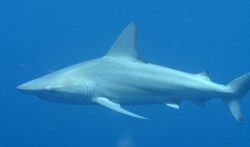select your film:


The Big-nose shark is a deep water species of requiem shark found in tropical and subtropical waters around the globe. They live on continental shelves at depths of 90m to 430m, although they have been observed much closer to the surface at night. They are grey or bronze on their topside and white underneath, with closely spaced, oval -shaped dermal denticles. They subsist predominantly on a diet of bony fishes, cartilaginous fishes (including other sharks) and cephalopods.
They’re viviparous and the average litter size is around 7 pups, although there can be as many as 13. Size at birth is between 70cm and 90cm. Males reach maturity at 2.16m and females do so at 2.26m. The maximum total length for this species is at least 2.8m and the heaviest specimen ever recorded was 168kg. Despite their substantial size, they pose little threat to humans as they are deep water dwellers.
The bignose shark is targeted by commercial fisheries in some areas. In Cuba, they are fished for their liver oil and to make shagreen and in southeast Asia they are sought for their meat and their fins. In the northwestern Atlantic, this species is classified as Near Threatened but due to poor population monitoring of their global range and abundance in other areas there isn’t enough information to assess their population health. Their conservation status is “Data Deficient.”
Do you have images or videos of Bignose Sharks?
Submit them to [email protected].
